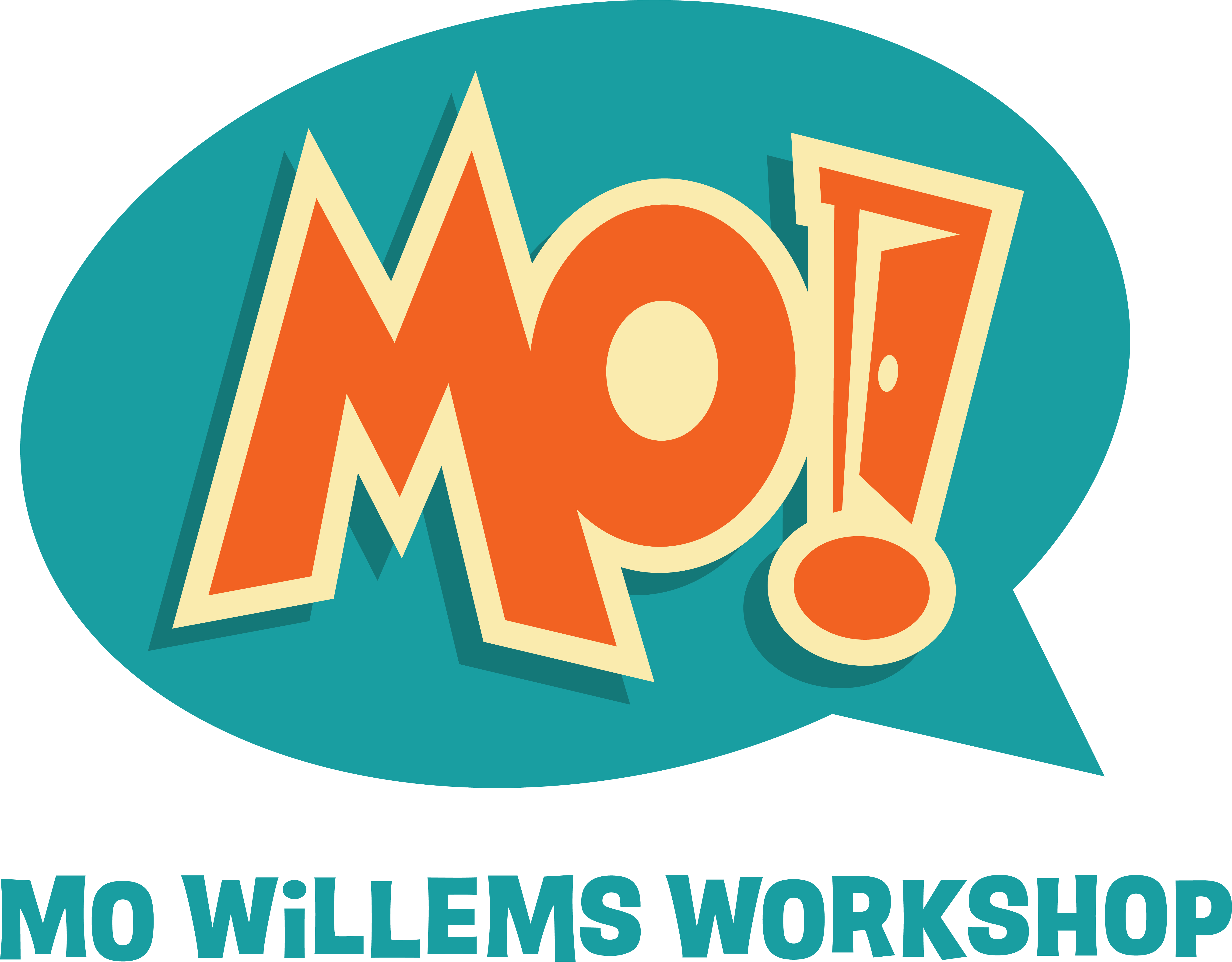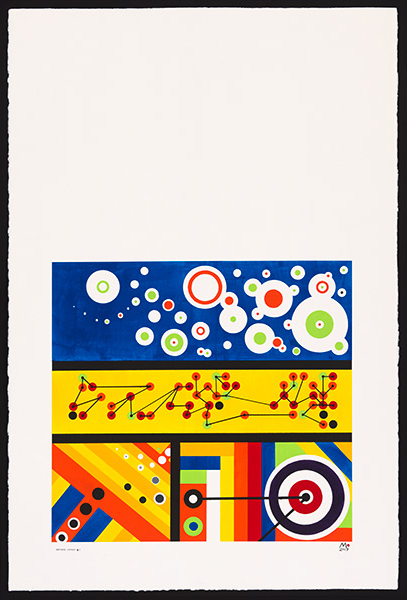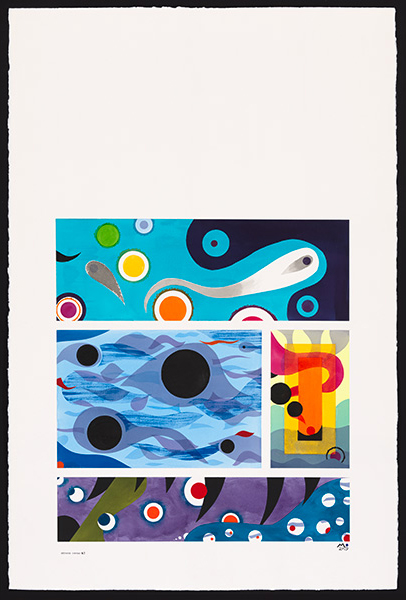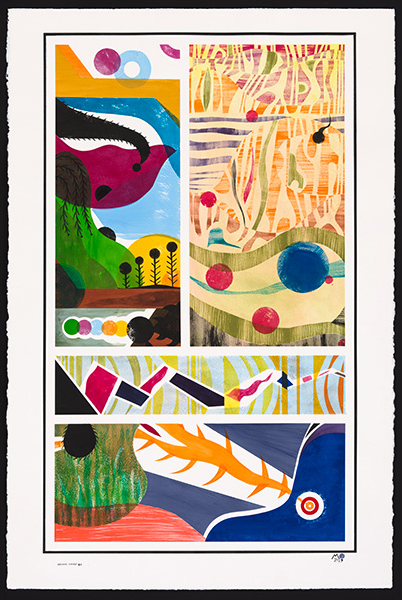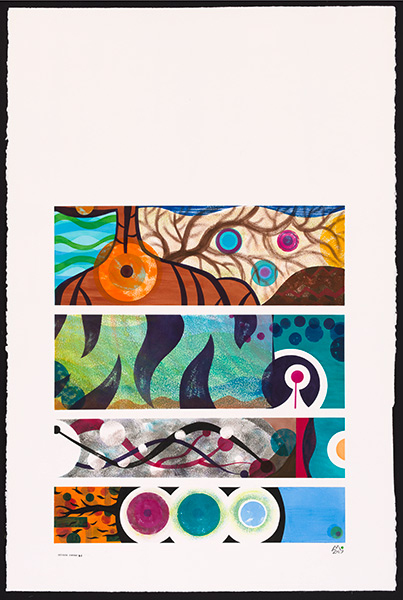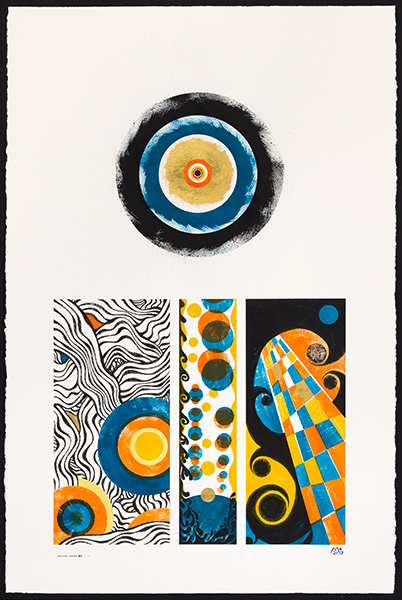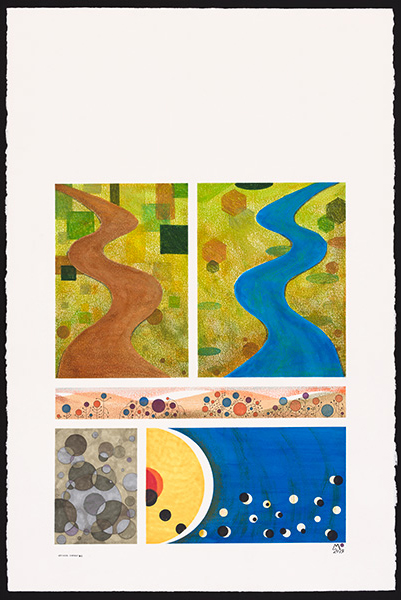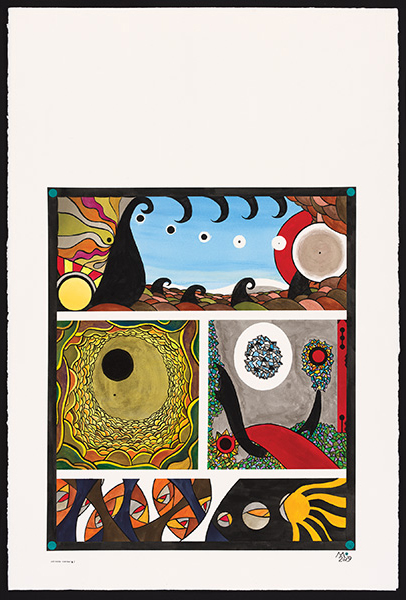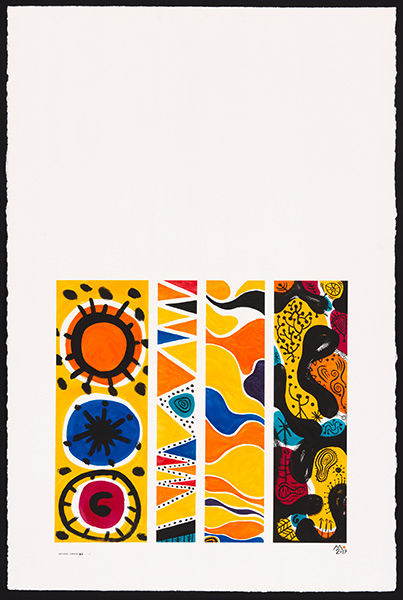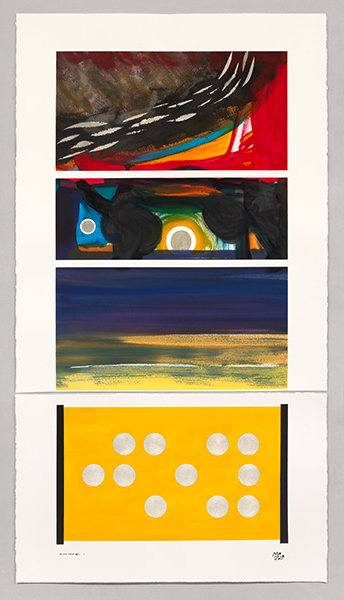Symphony No. 1 - Beethoven Symphonies Abstracted: Mo Willems | With Gianandrea Noseda of the NSO
APPROX. 27 MINUTES
60¼" x 40¼"
Mixed media on paper
Each panel in this work represents a symphonic ‘movement.’ The panels’ sizes are determined by the length of the movement. If the whole sheet of paper represents an hour, then you can see that the first symphony’s four sections take a little under half an hour to be performed. Just as Beethoven is obviously beholden to his predecessors, Haydn and Mozart, in his first symphony, this painting borrows liberally from constructivism, an early, formal abstraction style.
Artwork © Mo Willems
Symphony No. 2 - Beethoven Symphonies Abstracted: Mo Willems | With Gianandrea Noseda of the NSO
APPROX. 33 MINUTES
60¼" x 40¼"
Mixed media on paper
The sections of a symphony are called ‘movements’ because the music should ‘move’ you. Similarly, I want the images in each symphony to look as if they are alive and in transit. As Beethoven loosens up in his second symphony, so does this painting, with the fundamental circles (or notes?) being guided throughout the work in and on waves of colored ink. It is the circles’ journeys that connect all nine paintings.
Artwork © Mo Willems
Symphony No. 3 - Beethoven Symphonies Abstracted: Mo Willems | With Gianandrea Noseda of the NSO
APPROX. 50 MINUTES
60¼" x 40¼"
Mixed media on paper
The third symphony is considered one of Beethoven's greatest musical innovations. It celebrates 'heroic' conquests and martial glory as embodied by Napoleon Bonaparte. At least it did until the French dictator invaded Austria and Ludwig changed his mind about him. The painting’s final movement evokes Napoleon's famous tri-corner hat knocked over, a literal tip of the hat to Beethoven having angrily scratched Napoleon’s name off the score’s title page and renaming it 'Eroica.'
Artwork © Mo Willems
Symphony No. 4 - Beethoven Symphonies Abstracted: Mo Willems | With Gianandrea Noseda of the NSO
APPROX. 33 MINUTES
60¼" x 40¼"
Mixed media on paper
A typical symphony will have a strictly 'fast' movement followed by a strictly 'slow' movement. Beethoven is too restless for that. He fully explores his musical ideas in all tempos and volume, much as a scientist approaches a question from multiple angles. Like a good scientist, Ludwig’s skill is always underlined by a sense of wonder. The fourth symphony found me visiting and exploring different environments that turned out to be connected.
Artwork © Mo Willems
Symphony No. 5 - Beethoven Symphonies Abstracted: Mo Willems | With Gianandrea Noseda of the NSO
APPROX. 30 MINUTES
60¼" x 40¼"
Mixed media on paper
Beethoven’s music achieved the immortality he desired with the first four notes of this symphony. The notes shocked and reverberated like an electric power-cord when it was first performed, and still do today. Consequently, the representation of the first movement demanded a new shape, fundamentally different, yet universal. This is the first time that gold leaf is used in any of the paintings.
Artwork © Mo Willems
Symphony No. 6 - Beethoven Symphonies Abstracted: Mo Willems | With Gianandrea Noseda of the NSO
APPROX. 39 MINUTES
60¼" x 40¼"
Mixed media on paper
The sixth, known as the Pastoral, is Ludwig’s least abstract symphonic work. Meant to symbolize the restorative delights of a visit to the country, each movement represents a sound picture (a road leading from city to village, a babbling brook, locals dancing, a storm, dawn). This is the first abstraction to incorporate pencil, an essential tool for sketching ideas when artists and composers leave the studio for the country.
Artwork © Mo Willems
Symphony No. 7 - Beethoven Symphonies Abstracted: Mo Willems | With Gianandrea Noseda of the NSO
APPROX. 38 MINUTES
60¼" x 40¼"
Mixed media on paper
Pretty much the platonic ideal of the symphony form, Beethoven’s seventh has become a personal favorite. There is a dramatic grandeur mixed with a light touch that always surprises, even if one listens to it over and over for many, many months... Creating this abstraction was also filled with surprises. The designs journeyed far and wide over a series of drafts, touching on Norse inspired voyages, art deco materials, and Japanese wood block prints.
Artwork © Mo Willems
Symphony No. 8 - Beethoven Symphonies Abstracted: Mo Willems | With Gianandrea Noseda of the NSO
APPROX. 25 MINUTES
60¼" x 40¼"
Mixed media on paper
Often said to be the 'funny' symphony, Beethoven's eighth has a light playful tone. The second movement is said to spoof a brand-new gadget that became the rage in Vienna, the metronome (a kind of musical 'app' that rendered having a sense of rhythm redundant). The colors in this painting evoke the work of Alexander Calder, a personal hero and the funniest of the serious abstract artists of the last century.
Artwork © Mo Willems
Symphony No. 9 - Beethoven Symphonies Abstracted: Mo Willems | With Gianandrea Noseda of the NSO
APPROX. 70 MINUTES
74⅛" x 40¼"
Mixed media on paper
Ludwig throws everything at us in the ninth. His longest symphony, it even includes a choral movement, a symphonic first. Much like the later abstract expressionists that the first three panels of this work reference (Pollock, Frankenthaler), Beethoven seems confident enough in his creation not to care what his audience thinks. The final movement’s sense of spiritual enlightenment is represented by a series of simple silver disks, that spell the word JOY in braille.
Artwork © Mo Willems
